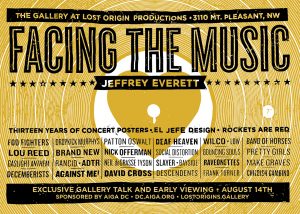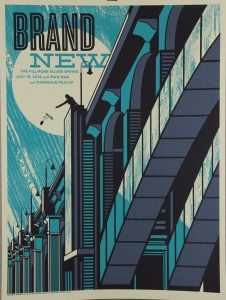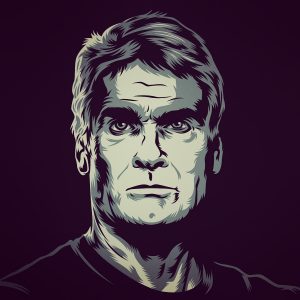 Jeffrey Everett, the designer behind Rockets Are Red and El Jefe Design, is putting together a poster retrospective at The Gallery at Lost Origin Productions. “Facing the Music: Thirteen Years of Concert Posters” officially opens Aug. 15, but Everett will give an exclusive talk for AIGA DC on Aug. 14 (register here). Everett took some time to talk with us about his work, designing for bands, and why he calls D.C. home.
Jeffrey Everett, the designer behind Rockets Are Red and El Jefe Design, is putting together a poster retrospective at The Gallery at Lost Origin Productions. “Facing the Music: Thirteen Years of Concert Posters” officially opens Aug. 15, but Everett will give an exclusive talk for AIGA DC on Aug. 14 (register here). Everett took some time to talk with us about his work, designing for bands, and why he calls D.C. home.
Full disclosure: We spent the first ten minutes nerding out about setting our favorite songs as our ringtones, then letting our phones ring so we can hear them. But then we got down to business.
AIGA DC: What’s your superhero origin story? How did you start doing concert posters?
Everett: I started back in late 2003, 2004 when I was taking screen printing classes at the School of Visual Arts while I was getting my master’s degree. I had this old hippie teacher who kept saying, “Just print something.”
Being a designer, I like working with clients. So when one of my favorite bands of all time, Firewater, was playing a show the Bowery Ballroom, I contacted them and said, “Hey, can I do posters for you?” I think the lead singer Tod was like, “Okay … sure.”
So I ended up doing a bunch of posters. I got into the show, and I got to hang out with a very inebriated band afterward. People started to find me and say, “Hey, we’ll pay you for a poster,” and I was like, “This is pretty cool.”
I moved from New York to D.C., and when bands would come into town, I’d reach out to them. There were a lot of cold calls, a lot of cold emails — and it snowballed from there.

By Jeffrey Everett
AIGA DC: Are you still reaching out to bands, or is everyone coming to you at this point?
Everett: It’s probably 75% of people reaching out to me, but I’ve moved away from doing so many concert posters. The industry and the business model have drastically changed, and it’s not as much fun anymore.
AIGA DC: What changed?
Everett: A lot of people count nickels and dimes, and have this idea that somebody will do the work for free.
Even when I first started doing this, other people in my field told me, “You should be doing this for the scene, you shouldn’t be making money off of this. Do it for the appreciation of the music.”
Which seems — to be blunt — like a bullshit elitist attitude. This idea that I can just do work for free, that I should spend 50 hours working on a poster, and then just give it away. Yeah, I love bands, but I’ve always been like, “Hey, you’re making money off my work. I should also be making money off my work.”
And ultimately, asking for free work is really disrespectful to the audience, because when you get free work out of people, it’s usually crappy free work.
One of my former clients had a person who came in and started doing work that looked like mine. Then people realized it wasn’t mine, and so the band looks bad, and that artist looks bad. I look bad, because people actually thought it was mine for a while. Meanwhile, no one’s buying the artwork. So the client saved a little money, but lost a lot more.
AIGA DC: When you did your first poster for Firewater, did you charge them? Or did you do it for free?
Everett: No, I did it for free, but it was “free” with air quotes. I did the design and printing for free, but I also said I wanted to be able to sell the posters. And that was my payment. I think I made $500, which, when you’re first starting out, isn’t bad.
AIGA DC: I feel like that’s tough, especially for young designers. They want portfolio items, things to show. How do they do that before somebody is going to pay them up front?
Everett: There’s nothing wrong with study work, of creating projects for yourself, doing work to show what your skills are. When I had my first job out of college, I’d get home at night and design just to keep myself interested, so I could work and figure things out. I did posters for fake bands, and redesigned CDs for musicians who I thought had bad design. They became my portfolio pieces to get into grad school.
And that’s how I got into it all. Creating projects for myself, things that interested me, and figuring that if I like it, then there are probably other people who will like it, too.
AIGA DC: So the show covers 13 years of work. Why is now a good time for a retrospective?
Well, 13 years is just funny. But the way this happened was that I was doing a record for this band called Battery, who are like the leaders of the second-wave of hard core bands out of D.C.
I was at a show, and the drummer Jason was like, “Dude, I own a gallery!” and I was like “Cool, I want my work there!” Jason said, “Yeah, you should totally do this. How about in August?” And I thought, “Oh crap, now I actually have to do this.”
So, now I’m going through my portfolio. I have just over 250 concert posters. I’m hoping I can find 75 that don’t embarrass me. That would be an amazing feat.
AIGA DC: As you go through your work, are there themes or ideas you’re discovering?
[foogallery id=”191523″]
Everett: It’s interesting for me to see the evolution of all of them. Initially, I did very design-y looking posters. I kind of call them t-shirt posters. They’re very straightforward. Big name, big everything, made the logo as large as I could. There’s a lot of those I really like, but I kind of think of them as five-second ideas, in the sense that you see them and get the entire idea in five seconds. There’s no lingering thought to them.
In the work I do now, I actually figured out how to combine design with illustration. I approach the posters as a scene from a movie, where there’s a moment before and a moment after each one. And I leave it up to the viewer on how to interpret that.
For me, really good artwork for bands — like the classic record covers — were ones that you could stare at for a long time. That’s what I try to do now with my posters. Hopefully, people look at them and will stay for more than five seconds.
[foogallery id=”191525″]
AIGA DC: Switching gears a little — what drew you to D.C.?
Everett: I originally moved to D.C. when I was 18 or 19, coming for college. I grew up in a really small town in the middle of nowhere Massachusetts.
I love politics. I love literature. I love music and all that seemed to be emanating out of D.C. And it was a place I could get to and understand. It wasn’t so big I was scared.

Portrait of Henry Rollins – by Jeffrey Everett
I would think, “Henry Rollins is from D.C. I really like Henry Rollins. I should move to D.C.”
AIGA DC: What do you see in the creative community in D.C.?
Everett: I think what amazes me about the D.C. creative community is just how smart people are.
I’ll kind of compliment the AIGA people here, like [D.C. chapter board member] Dian Holton, and [national board member] Ashleigh [Axios], and [D.C. chapter advisory board member] Mira [Azarm].
I’m probably a decade older, and I’m just gonna sit down and shut up and listen because people are so smart and they’re so on it. There’s creativity, but there’s depth and knowledge that goes on behind that creativity.
***
Want a sneak peek? AIGA DC is hosting an exclusive event with Jeffrey Everett on Aug. 14, the night before the show officially opens. Registration opens at noon, Wednesday, Aug. 2. “Facing the Music: Thirteen Years of Concert Posters” will be open to the public at The Gallery at Lost Origin Productions through Sept. 5.
***
Like what you read? Check out more events and blog posts from AIGA DC. Find us on Twitter, Instagram and Facebook.